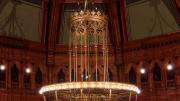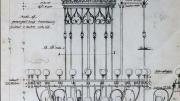The ceiling of Sanders Theatre soars so high, it makes you look up, says Raymond Traietti, assistant director of Memorial Hall. That’s when the grandest antique chandelier in all of Boston—a 1,040-pound, glowing dewdrop of nineteenth-century iron and brass—meets the eyes. The chandelier, he adds, “acts as the constellation for that space.”
With 72 individual lamps, ribbon-like brass tubing and fixtures, and concentric wheels of light, the Sanders chandelier is a functioning work of art—just as Memorial Hall’s architects, William Robert Ware, Class of 1852, and Henry Van Brunt, Class of 1854 (who designed every detail of the building, down to its doorknobs) intended.
Majestic chandeliers graced many churches and lecture halls in the late 1800s, when Memorial Hall was built, Traietti says. (Newbury Street’s Church of The Covenant, for instance, is home to a famous Tiffany example from 1893.) But the Sanders chandelier is especially noteworthy because it has withstood the test of time, providing the auditorium’s primary light source throughout the building’s 138-year history.
Originally fitted with gas lamps, the chandelier went electric in the 1920s. In May 2015, Traietti’s staff lowered it some 35 feet to the floor to replace its 40-watt light bulbs with super efficient, 4.5-watt LED lighting. “That was the final step that got me thinking, ‘Now we’ve brought it to the modern age,’” he says. “We have lost a little bit of that warm glow you have with incandescent lights. But Sanders is used so much—there are performances and rehearsals just about every evening, there are classes by day, and we’re cleaning three to four hours a night—that the energy savings is tremendous.” With LEDs, and a totally revamped support cable system, the chandelier is poised to light the way for further generations of Sanders-goers. All they need do is look up.










